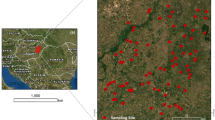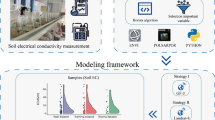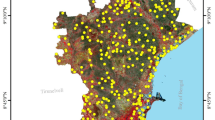Abstract
In most tropical climates, one of the most serious natural dangers that negatively impacts agricultural operations in coastal regions is increasing sea levels because of climate alteration-induced soil salinity. This problem has become worse and has been happening more often in Vietnam’s Mekong River Delta. Utilizing Sentinel-1 SAR C-band data in conjunction with 5 cutting-edge machine learning models—MLP-NN, RBF-NN, Gaussian Processes, SVR, and RF—the primary goal of the research is to map soil salinity invasion in Ben Tre region that is situated on the Mekong River Delta of Vietnam. In order to do this, 65 soil specimens were gathered in the grassland observation that took place between August 9 and 11, 2022, in accordance with the Sentinel-1 SAR images. The root-mean-square error, mean absolute error, and correlation coefficient were utilized to find and compare the performance of the 5 models. The GP model beat the other machine learning models and produced the best estimation performance (RMSE = 2.116, MAE = 1.247, and correlation coefficient = 0.904), according to the findings. We come to the conclusion that the latest machine learning models may be utilized to map the salinity of the soil in the Delta regions, offering a helpful tool to help farmers and policy makers choose more suitable crop varieties in light of climate change.






Similar content being viewed by others
Data availability
The authors have data in a repository and will be made available on request.
References
Khanh PT, Ngọc TH, Pramanik S (2023) Future of smart agriculture techniques and applications. In: Khang A (ed) Handbook of Research on AI-Equipped IoT Applications in High-Tech Agriculture. IGI Global. https://doi.org/10.4018/978-1-6684-9231-4.ch021
Ngọc TH, Khanh, PT Pramanik S (2023) Smart agriculture using a soil monitoring system. In: Khang A (ed) Advanced Technologies and AI-Equipped IoT Applications in High Tech Agriculture, IGI Global
Lv Z, Zhang P, Sun W, Benediktsson JA, Li J, Wang W (2023) Novel adaptive region spectral–spatial features for land cover classification with high spatial resolution remotely sensed imagery. IEEE Trans Geosci Remote Sens 61:1–12. https://doi.org/10.1109/TGRS.2023.3275753. 5609412
Roy SK, Deria A, Hong D, Rasti B, Plaza A, Chanussot J (2023) Multimodal fusion transformer for remote sensing image classification. IEEE Trans Geosci Remote Sens 61:1–20. https://doi.org/10.1109/TGRS.2023.3286826. 5515620
Liu L, Yu Z (n.d.) Low error and broadband microwave frequency measurement using a silicon mach–Zehnder interferometer coupled ring array. J Lightwave Technol. https://doi.org/10.1109/JLT.2023.3278325
Quettier L et al (2023) Progress toward medical use of the Iseult Whole Body 11.7 T MRI: First omages. Trans Appl Supercond 33(5):1–7. https://doi.org/10.1109/TASC.2023.3244117. 4400607
Pramanik S (2023) Intelligent farming utilizing a soil tracking device. In: Sharma AK, Chanderwal N, Khan R (eds) Convergence of Cloud Computing, AI and Agricultural Science, IGI Global
Ahmed U et al (2022) Prediction of diabetes empowered with fused machine learning. IEEE Access 10:8529–8538. https://doi.org/10.1109/ACCESS.2022.3142097
Li Y et al (2022) Satellite-based assessment of meteorological and agricultural drought in Mainland Southeast Asia. IEEE J Sel Top Appl Earth Obs Remote Sens 15:6180–6189. https://doi.org/10.1109/JSTARS.2022.3190438
Pramanik S (2022) An effective secured privacy-protecting data aggregation method in IoT. In: Odhiambo MO, Mwashita W (eds) Achieving Full Realization and Mitigating the Challenges of the Internet of Things, IGI Global. https://doi.org/10.4018/978-1-7998-9312-7.ch008
Fuqiang T, Yonghuan T, Jiabao W, Shuting Z, Jinmei C (2023) Study on the frequency and temperature dependence of electrical conductivity of zinc oxide valve plate. IEEE Trans Dielectr Electr Insul 30(3):1302–1311. https://doi.org/10.1109/TDEI.2022.3233940
Jayasingh R, Kumar J, Telagathoti RJSDB, Sagayam KM, Pramanik S (2022) Speckle noise removal by SORAMA segmentation in digital image processing to facilitate precise robotic surgery. Int J Reliable Qual E-Healthcare 11(1). https://doi.org/10.4018/IJRQEH.295083
Bansal R, Obaid AJ, Gupta A, Singh R, Pramanik S (2021) Impact of big data on digital transformation in 5G Era. 2nd International Conference on Physics and Applied Sciences (ICPAS 2021). https://doi.org/10.1088/1742-6596/1963/1/012170
Pramanik S, Bandyopadhyay S (2023) Identifying disease and diagnosis in females using machine learning. In: Wang J (ed) Encyclopedia of Data Science and Machine Learning, IGI Global. https://doi.org/10.4018/978-1-7998-9220-5.ch187
Pramanikand S, Bandyopadhyay S (2023) Analysis of big data. In: Wang J (ed) Encyclopedia of Data Science and Machine Learning, IGI Global. https://doi.org/10.4018/978-1-7998-9220-5.ch006
Bansal R, Jenipher V N, Jain R, Dilip R, Kumbhkar M, Pramanik S, Roy S, Gupta A (2022) Big Data Architecture for Network Security. In: Cyber Security and Network Security. Wiley, pp 233–267. https://doi.org/10.1002/9781119812555.ch11
Anand R, Singh J, Pandey D, K.Pandey B, Nassa VK, Pramanik S, Ghonge MM, Pramanik S (2022) Modern technique for interactive communication in LEACH-Based Ad Hoc wireless sensor network. In: Ghonge MM, Pramanik S, Potgantwar AD (eds) Software Defined Networking for Ad Hoc Networks, Springer. https://doi.org/10.1007/978-3-030-91149-2_3
Choudhary S, Narayan V, Faiz M, Pramanik S (2022) Fuzzy approach-based stable energy-efficient AODV routing protocol in Mobile ad hoc networks. In: Ghonge MM, Pramanik S, Potgantwar AD (eds) Software defined networking for ad Hoc Networks, Springer. https://doi.org/10.1007/978-3-030-91149-2_6
Dushyant K, Muskan G, Annu, Gupta A, Pramanik S (2022) Utilizing machine learning and deep learning in cybesecurity: an innovative approach. In: Cyber Security and Digital Forensics: Challenges and Future Trends, Wiley, pp 271–293. https://doi.org/10.1002/9781119795667.ch12
Pandey BK, Pandey D, Wairya S, Agarwal G, Dadeech P, Dogiwal SR, Pramanik S (2022) Application of integrated steganography and image compressing techniques for confidential information transmission. In: Wiley (ed) Cyber Security and Network Security. https://doi.org/10.1002/9781119812555.ch8
Anisetti M, Ardagna CA, Balestrucci A, Bena N, Damiani E, Yeun CY (n.d.) On the robustness of random forest against untargeted data poisoning: an ensemble-based approach. IEEE Trans Sustain Comput. https://doi.org/10.1109/TSUSC.2023.3293269
Pramanik S, Galety MG, Samanta D, Joseph NP (2022) Data mining approaches for decision support systems. 3rd International Conference on Emerging Technologies in Data Mining and Information Security
Praveenkumar S, Veeraiah V, Pramanik S, Basha SM, Lira Neto AV, De Albuquerque VHC, Gupta A (2023) Prediction of patients’ incurable diseases utilizing deep learning approaches, ICICC 2023, Springer. https://doi.org/10.1007/978-981-99-3315-0_4
Vera A, Kusnadi IZ, Pane MV, Overbeek, Prasetya SG (2023) Face recognition accuracy improving using gray level co-occurrence matrix selection feature algorithm. 2023 International Conference on Smart Computing and, Application (ICSCA), Hail, Saudi Arabia, pp 1–6. https://doi.org/10.1109/ICSCA57840.2023.10087414
Narayan V, Mall PK, Awasthi S, Srivastava S, Gupta A, FuzzyNet (2023) Medical image classification based on GLCM texture feature. 2023 International Conference on Artificial Intelligence and Smart Communication (AISC), Greater Noida, India, pp 769–773. https://doi.org/10.1109/AISC56616.2023.10085348
González-Palacio M, Tobón-Vallejo D, Sepúlveda-Cano LM, Rúa S, Le LB (2023) Machine-learning-based combined path loss and shadowing model in LoRaWAN for energy efficiency enhancement. IEEE Internet Things J 10(12):10725–10739. https://doi.org/10.1109/JIOT.2023.3239827
Le T-D, Noumeir R, Rambaud J, Sans G, Jouvet P (2023) Adaptation of autoencoder for sparsity reduction from clinical notes representation learning. IEEE J Transl Eng Health Med 11:469–478. https://doi.org/10.1109/JTEHM.2023.3241635
Zanchettin AM, Casalino A, Piroddi L, Rocco P (2019) Prediction of human activity patterns for human–Robot Collaborative Assembly tasks. IEEE Trans Industr Inf 15(7):3934–3942. https://doi.org/10.1109/TII.2018.2882741
Mendes N (2022) Surface electromyography signal recognition based on deep learning for Human-Robot Interaction and collaboration. J Intell Robot Syst 105:42. https://doi.org/10.1007/s10846-022-01666-5
Garcia PP, Santos TG, Machado MA, Mendes N (2023) Deep learning framework for controlling work sequence in Collaborative Human–Robot Assembly processes. Sensors 23(1):553. https://doi.org/10.3390/s23010553
Dhindsa IS, Gupta R, Agarwal R (2022) Binary particle swarm optimization-based feature selection for predicting the class of the knee angle from EMG signals in lower limb movements. Neurophysiology 53:109–119. https://doi.org/10.1007/s11062-022-09922-y
Funding
The authors did not receive any funding.
Author information
Authors and Affiliations
Corresponding author
Ethics declarations
Conflict of interest
The authors do not have any conflict of interest.
Additional information
Publisher’s Note
Springer Nature remains neutral with regard to jurisdictional claims in published maps and institutional affiliations.
Rights and permissions
Springer Nature or its licensor (e.g. a society or other partner) holds exclusive rights to this article under a publishing agreement with the author(s) or other rightsholder(s); author self-archiving of the accepted manuscript version of this article is solely governed by the terms of such publishing agreement and applicable law.
About this article
Cite this article
Khanh, P.T., Ngoc, T.T.H. & Pramanik, S. Evaluation of machine learning models for mapping soil salinity in Ben Tre province, Vietnam. Multimed Tools Appl (2024). https://doi.org/10.1007/s11042-024-18712-z
Received:
Revised:
Accepted:
Published:
DOI: https://doi.org/10.1007/s11042-024-18712-z




